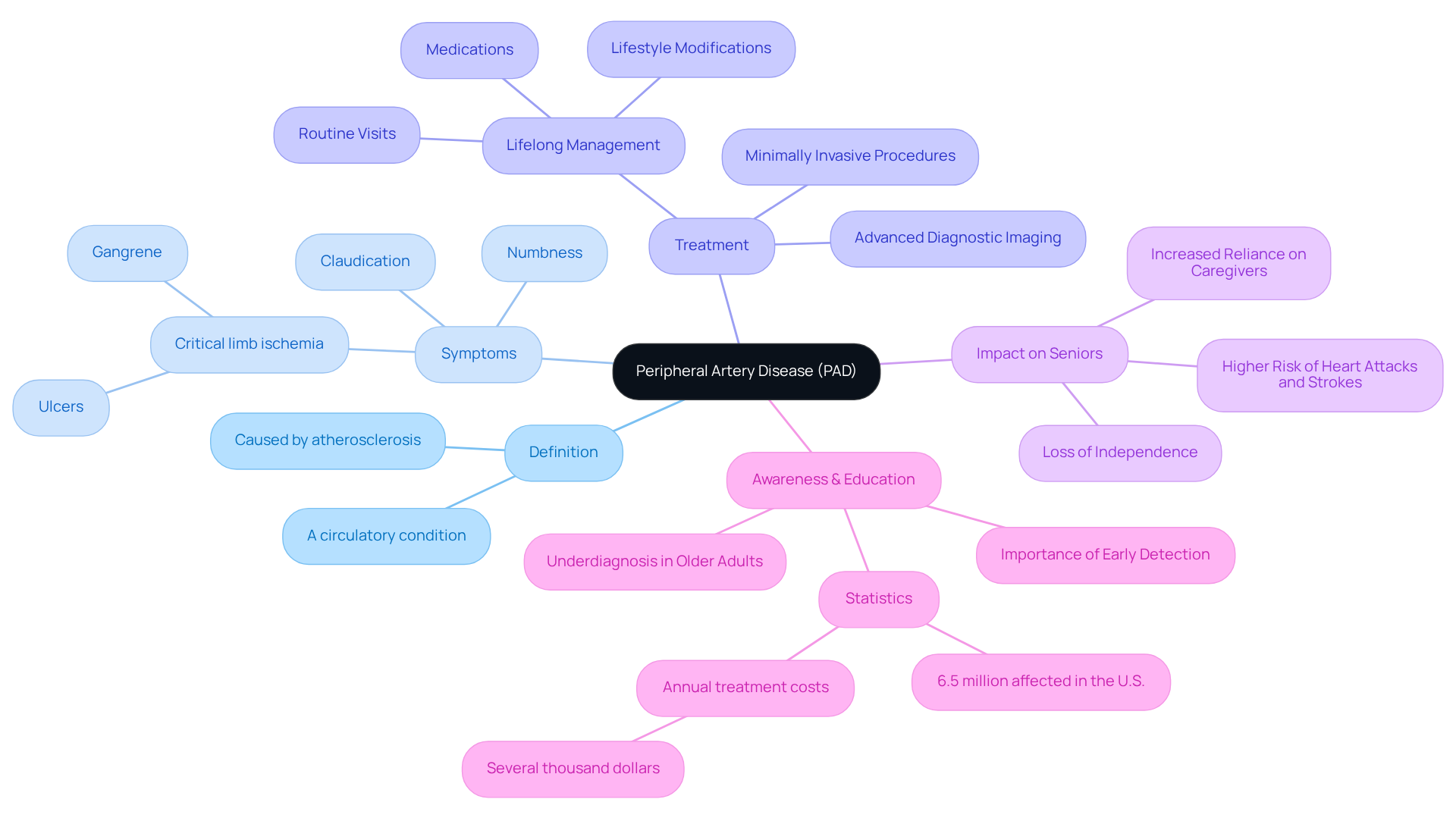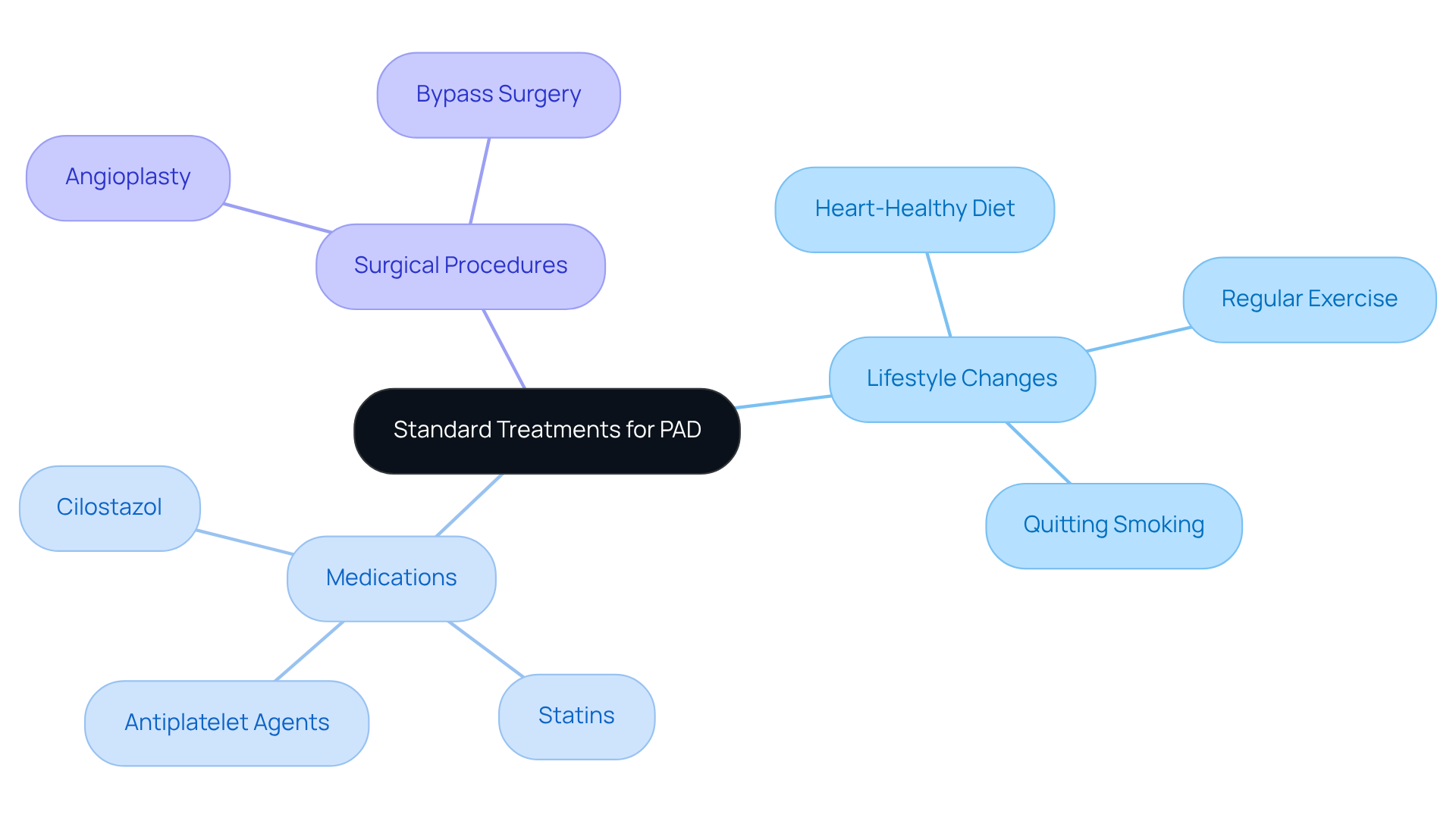


Are you or a loved one struggling with Peripheral Artery Disease (PAD)? It’s a condition that can deeply affect mobility and overall quality of life, leaving many feeling anxious about their health. But there’s good news! Recent advancements in treatments for PAD are paving the way for better patient care and outcomes.
Innovative options like minimally invasive procedures and new pharmacological therapies are making a real difference. These treatments not only aim to improve blood flow but also focus on creating personalized care plans tailored to individual needs. Imagine regaining the ability to enjoy daily activities without the burden of pain or discomfort. This is now more achievable than ever.
Furthermore, these developments can significantly enhance your mobility and overall well-being. It’s important to know that you’re not alone in this journey. Many patients have found renewed hope and vitality through these new approaches. Have you considered discussing these options with your healthcare provider?
As you explore these possibilities, remember that support is always available. Reaching out for help can be the first step toward a more active and fulfilling life. Your health matters, and with the right care, you can take control of your PAD journey. Don’t hesitate to seek the guidance you deserve.
Peripheral Artery Disease (PAD) is a silent yet significant health concern that affects millions, especially seniors. It restricts blood flow to the limbs, leading to debilitating symptoms that can be distressing. As awareness grows, so does the potential for innovative treatments that promise to enhance quality of life and restore independence.
But with so many options available, how can individuals navigate the complexities of PAD management? It’s understandable to feel overwhelmed. This comprehensive guide delves into the latest advancements and personalized strategies for treating PAD, offering hope and clarity for those affected by this condition.
In addition to this, we’ll explore how these solutions can be tailored to meet your unique needs. Remember, you’re not alone in this journey. Together, we can find the most effective ways to manage PAD and improve your quality of life.
Peripheral Artery Disease (PAD) is a common circulatory condition that can significantly impact your daily life. It occurs when arteries narrow, limiting blood flow to your limbs, especially your legs. This narrowing often results from atherosclerosis, where fatty deposits build up in the artery walls. If you’ve experienced leg pain during activities, known as claudication, or numbness, you’re not alone. In severe cases, PAD can lead to critical limb ischemia, causing ulcers or gangrene, which can affect your mobility and overall quality of life.
At Amavita Heart and Vascular Health, we understand the challenges associated with new treatments for PAD. Our specialists are committed to providing expert treatment and exploring new treatments for PAD as well as Chronic Venous Insufficiency (CVI). We use advanced diagnostic imaging to pinpoint blockages and offer minimally invasive procedures that can restore blood flow to your legs. Many of our patients report significant improvements in their walking distance and pain relief, often returning home the same day after outpatient procedures.
For seniors, the effects of PAD can be particularly concerning. This condition can make daily activities more difficult, leading to a loss of independence and increased reliance on caregivers. Early diagnosis and proactive management are crucial to prevent complications like heart attacks or strokes, which are more common in those with PAD. Cardiologists emphasize that recognizing the signs early can lead to better outcomes, as timely intervention can slow the disease's progression. Dr. David G. Armstrong, a leading expert in the field, notes, "Patients with chronic limb-threatening ischemia (CLTI) do better when they are treated by a team," underscoring the importance of a collaborative approach in managing PAD.
Recent studies reveal that PAD is often underdiagnosed, particularly among older adults. Approximately 6.5 million people aged 40 and older in the United States are affected by this condition. Many individuals share their experiences of struggling to walk or engage in activities they once enjoyed, highlighting the need for increased awareness and education about PAD and CVI. This is especially vital for seniors, as early detection and effective intervention can make a significant difference in their lives. Furthermore, ongoing research into the causes of PAD continues to evolve, providing insights that can lead to new treatments for PAD and better management and outcomes for those affected. At Amavita, our commitment to research and innovation ensures that our patients benefit from the latest therapies, often before they become widely available elsewhere.

If you or a loved one is facing Peripheral Artery Disease (PAD), it’s natural to feel concerned about your health. Understanding the steps you can take to manage this condition can be empowering. Conventional approaches for PAD often include lifestyle changes, medications, and, in some cases, new treatments for PAD like surgical procedures.
Making essential lifestyle changes can significantly enhance your vascular health. Consider adopting a heart-healthy diet filled with fruits, vegetables, and whole grains. Engaging in regular exercise—aiming for at least three sessions a week—can also make a difference. And if you smoke, quitting is one of the best gifts you can give your body. These changes not only help manage PAD but also improve your overall well-being.
New treatments for PAD include medications that play a crucial role in managing the condition. Antiplatelet agents like aspirin or clopidogrel are commonly prescribed to help prevent blood clots. Statins can assist in lowering cholesterol levels, which is vital for heart health. Another effective option is cilostazol, which enhances blood circulation and alleviates the discomfort of claudication, an issue commonly addressed by new treatments for PAD.
In more severe cases, new treatments for PAD may necessitate surgical interventions. Procedures like angioplasty, which uses a balloon to open narrowed arteries, and bypass surgery aim to restore blood flow. These interventions work together to alleviate symptoms, enhance mobility, and significantly lower the risk of serious cardiovascular events. It’s reassuring to know that these approaches align with the latest clinical guidelines, emphasizing a comprehensive strategy for managing PAD.
Remember, you’re not alone in this journey. Seeking support and guidance from healthcare professionals can make a world of difference. If you have questions or need assistance, don’t hesitate to reach out. Your health and comfort are what truly matter.

The landscape of care is being transformed by new treatments for PAD, which offer hope through minimally invasive procedures and innovative pharmacological therapies. At Amavita Heart and Vascular Health, we understand the concerns of high-risk individuals and are dedicated to providing focused cardiovascular treatment with the convenience of same-day service. Recent advancements, like drug-eluting balloons and stents, are designed to keep arteries open for longer, which can significantly reduce the need for repeat interventions. These devices have proven effective in improving outcomes, with studies showing they enhance blood flow and relieve symptoms associated with PAD.
In addition to these advancements, we are excited about the potential of regenerative medicine approaches, such as stem cell therapy and gene therapy, which are being actively researched to promote healing and improve circulation in affected areas. Clinical trials are currently evaluating the effectiveness of GLP-1 receptor agonists, which have shown promise in helping individuals with PAD walk further and reduce cardiovascular risks. For example, a study involving around 800 individuals with diabetes and PAD found that those treated with GLP-1 drugs experienced significant improvements in mobility and overall health.
These groundbreaking approaches represent a significant shift towards more personalized and effective management strategies for PAD, including new treatments for PAD, which offer renewed hope for a better quality of life for those affected by this condition. At Amavita, our specialists are committed to providing advanced procedures, including cardiac catheterization and stent placement, all with the convenience of same-day service. We want our patients to return to their daily lives without the burden of lengthy hospital stays.
If you or a loved one are facing the challenges of PAD, know that you are not alone. We are here to support you every step of the way, ensuring you receive the compassionate care you deserve.

Creating a personalized care strategy for Peripheral Artery Disease (PAD) starts with understanding your unique health situation, lifestyle, and specific symptoms, like leg discomfort or cramping when walking. At Amavita Heart and Vascular Health, our dedicated specialists use advanced diagnostic imaging to pinpoint any blockages. From there, we craft a comprehensive plan that includes lifestyle changes, medication management, and, if necessary, minimally invasive outpatient surgical options.
It's crucial to work closely with your healthcare provider. Regular follow-ups play a vital role in monitoring your condition and adjusting your care plan as needed, which can significantly impact your health outcomes. During these discussions, we consider various factors, including your existing health conditions, mobility levels, and personal preferences.
Have you thought about how supervised exercise programs could benefit you? Research shows that these programs can greatly improve walking ability and overall cardiovascular health. For example, participants in supervised exercise therapy have experienced impressive gains in walking performance, with average improvements in walking distance of:
This collaborative approach not only enhances the effectiveness of new treatments for PAD but also fosters a nurturing environment for managing the condition. At Amavita, we are committed to providing innovative and compassionate cardiovascular care, including new treatments for PAD, to ensure you feel supported every step of the way. Remember, you’re not alone in this journey; we’re here to help you thrive.

Understanding Peripheral Artery Disease (PAD) is crucial for effectively managing this condition. Recognizing the symptoms of PAD and knowing the treatment options available can significantly enhance your quality of life. By focusing on lifestyle changes, medication management, and innovative surgical interventions, it becomes clear that a comprehensive approach is essential for those affected by PAD.
Have you considered how early diagnosis can prevent complications? Lifestyle adjustments play a vital role in enhancing vascular health, and there are promising advancements in treatment technologies. From standard medications to groundbreaking therapies like regenerative medicine, the landscape of PAD treatment is evolving rapidly, offering hope for better patient outcomes. It’s important to remember that the collaborative effort between you and your healthcare provider is key in personalizing treatment plans that cater to your individual needs.
Ultimately, the message is clear: proactive management and awareness of PAD can lead to improved mobility and a better quality of life. If you’re affected by PAD, don’t hesitate to seek support and explore the latest treatment options available. By staying informed and engaged in your care, you can navigate the challenges of PAD more effectively, ensuring a healthier future. Remember, you’re not alone in this journey; support is available, and together, we can work towards a brighter tomorrow.
What is Peripheral Artery Disease (PAD)?
Peripheral Artery Disease (PAD) is a circulatory condition characterized by the narrowing of arteries, which limits blood flow to the limbs, particularly the legs. This narrowing is often caused by atherosclerosis, where fatty deposits accumulate in the artery walls.
What symptoms might indicate the presence of PAD?
Common symptoms of PAD include leg pain during activities, known as claudication, and numbness. In severe cases, it can lead to critical limb ischemia, resulting in ulcers or gangrene.
How does PAD affect seniors?
For seniors, PAD can significantly impact daily activities, leading to a loss of independence and an increased reliance on caregivers. Early diagnosis and proactive management are crucial to prevent complications such as heart attacks or strokes.
What treatments are available for PAD?
Treatments for PAD include advanced diagnostic imaging to identify blockages and minimally invasive procedures that can restore blood flow to the legs. Many patients experience significant improvements in walking distance and pain relief, often returning home the same day after outpatient procedures.
Why is early diagnosis important for PAD?
Early diagnosis is essential because recognizing the signs of PAD can lead to better outcomes. Timely intervention can slow the disease's progression and reduce the risk of serious complications like heart attacks or strokes.
How common is PAD among older adults?
PAD is often underdiagnosed, especially among older adults. Approximately 6.5 million people aged 40 and older in the United States are affected by this condition.
What is the importance of a collaborative approach in managing PAD?
A collaborative approach in managing PAD is important because patients with chronic limb-threatening ischemia (CLTI) tend to have better outcomes when treated by a team of specialists, as emphasized by Dr. David G. Armstrong.
What ongoing efforts are being made to improve PAD treatment and management?
Ongoing research into the causes of PAD is evolving, leading to new treatments and better management strategies. At Amavita, there is a commitment to research and innovation, ensuring that patients benefit from the latest therapies.